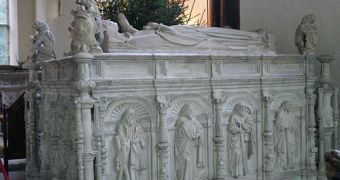Tools developed in Space Science will serve in the analysis of a group of Renaissance Tomb-Monuments in Suffolk, in order to unravel their mysterious past and give new insights into the Tudor Reformation, all this without touching the monuments.
This is an innovative Heritage Science project led by the University of Leicester, and it brings together space scientists, art-historians, archaeologists and museologists from Leicester, as well as historians from Oxford and Yale, and archaeologists and scientists from English Heritage.
First of all, the researchers will analyze the great Renaissance monuments of Thomas Howard, third Duke of Norfolk (1473 - 1554) and of Henry Fitzroy (1519 - 1536), Duke of Richmond, the illegitimate son of Henry VIII.
Principal Investigator Dr Phillip Lindley, from the University of Leicester Department of History of Art and Film, said that “both monuments seem to have been dramatically altered when they were moved in the middle of the sixteenth century from their original locations in Thetford Priory to Framlingham Parish Church, where they now stand.
“Puzzlingly, pieces excavated at Thetford in the 1930s seem to have originally belonged to these monuments and this suggests that they used to look very different from what we now see.
“We shall virtually disassemble the monuments and reconstruct their original forms for the first time in half a millennium, trying to integrate the excavated fragments in our virtual reconstructions.
“It is as if we have two (or more) three-dimensional jigsaws: we need first to sort the pieces out and then put them back together.”
Thanks to scanning and all the analytical techniques from Space Science, there is no need to even touch the monuments, and this is the whole idea of the project.
As for the original painted surfaces, material analysis using XRF, RAMIN, and other non-destructive techniques will give all the necessary information.
Dr Lindley said that the “key to this program is the innovative employment of techniques borrowed from Space Science, principally three-dimensional scanning and non-destructive materials analysis, to solve a complex set of historical, archaeological and art-historical problems.”
The project will also represent a case study, which will adapt techniques for analysis, display and interpretation, making them largely transferable, and contributing to the innovative deployment of science in the Cultural Heritage Sector.
Being an interdisciplinary research program in Cultural Heritage, it is funded by a major award from the Science and Heritage Program of the Arts and Humanities Research Council (AHRC) and the Engineering and Physical Sciences Research Council (EPSRC), of an overall value of £497,000 with an additional three fully-funded PhD studentships.
The research project is led by Dr Phillip Lindley and includes work teams from the University of Leicester departments of History of Art & Film (Dr Lindley, with Dr Jackie Hall), the Space Science Center (Prof George Fraser), Museum Studies (Dr Ross Parry) and Computer Science (Dr Effie Law), along with collaborating groups from Oxford (Dr Steve Gunn) and Yale universities (Dr Lisa Ford), and in English Heritage (Jan Summerfield, Dr Paul Bryan).

 14 DAY TRIAL //
14 DAY TRIAL //